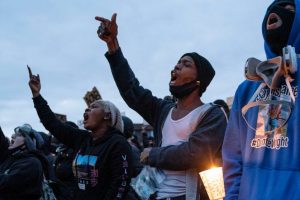Minnesota mayor blasts police tactics to control protesters

BROOKLYN CENTER, Minn. — Elected leaders in the Minneapolis suburb where a police officer fatally shot Daunte Wright want officers to scale back their tactics amid nightly protests, leaving some law enforcement called in to assist asking whether the city still wants their help.
Hundreds of demonstrators have gathered outside the heavily guarded Brooklyn Center police station every night since former Officer Kim Potter, who is white, shot the 20-year-old Black motorist during a traffic stop on Sunday. Protesters have shouted profanities and at times shaken a security fence police erected outside the building and lobbed water bottles at officers. Police have driven away protesters with tear gas grenades, rubber bullets, flash-bang grenades and long lines of riot police.
Xzavion Martin, 16, lives in an apartment across the street from the police station. He said rubber bullets and other projectiles have landed on his second-story balcony and tear gas has seeped inside.
“We can’t just have our window open any more without thinking about if there’s going to be some gas coming in,” he said. “There’s kids in this building that are really scared to come back. They are in hotels because of this.”
The tactics have not sat well with Brooklyn Center city officials.
Mayor Mike Elliott, who is Black, said at a news conference that “gassing is not a human way of policing” and he didn’t agree with police using pepper spray, tear gas and paintballs against demonstrators. Elliott didn’t respond to multiple messages Friday morning.
Protests have continued since Potter was charged Wednesday with second-degree manslaughter. The former police chief in the majority nonwhite suburb said Potter fired her pistol when she meant to use her Taser, but protesters and Wright’s family say there’s no excuse for the shooting. Both Potter and the chief resigned Tuesday.
The Brooklyn Center City Council on Monday passed a resolution banning the city’s officers from using tear gas and other chemicals, chokeholds and using police lines to arrest demonstrators. The resolution also allows protesters to videotape police.
But Brooklyn Center police aren’t dealing with protesters on their own. Other agencies, including the Hennepin County Sheriff’s Department and the Minnesota National Guard, have provided support at the city’s request in a joint effort dubbed Operation Safety Net. The city’s resolution isn’t binding on those agencies.
Sheriff David Hutchinson asked Elliott in a letter on Wednesday to clarify whether he still wanted the department’s help.
“The city’s actions since Sunday evening have created significant confusion,” Hutchinson wrote. “In order to maintain peace and safety, it is critical that the City of Brooklyn Center communicate with its State, County, and local law enforcement partners regarding its ongoing need for mutual aid.”
A spokesman for Hutchinson’s department had no immediately comment when asked about whether the back-and-forth with the city has resulted in any tactical changes or agencies pulling out. Messages left with Operation Safety Net and the office of Gov. Tim Walz, who doubles as commander-in-chief of the Minnesota National Guard, were not immediately returned Friday.
Walz, a Democrat, said at a Thursday news conference that he’s concerned about tactics but that police are trying to protect the community.
Tensions in the area were already high amid the nearby trial of former Minneapolis Police Officer Derek Chauvin in the death last year of George Floyd. The release Thursday of graphic police body camera footage showing a Chicago officer fatally shooting 13-year-old Adam Toledo, a Hispanic boy, in March has further enflamed the situation.
Brooklyn Center has instituted a curfew each night, but in the last few nights, the gatherings have been declared unlawful well before then.
Local Progress Minnesota, a group of liberal-leaning local elected officials, echoed the call for an end to using tear gas and said curfew declarations should also end.
“The last few nights have been marred with unconscionable acts of oppression,” the group said in a letter. “This is not how we build a safer place for one another.”
Walz told reporters that protesters might have burned down the police station and other buildings if police hadn’t intervened — lessons he learned after a Minneapolis police station burned during protests last year over Floyd’s death. Those demonstrations damaged more than 1,000 buildings across the Twin Cities area.
“I’ve learned from the past,” Walz said. “(The Brooklyn Center station) would have been burned down, and my fear is the surrounding apartments would have been burned, too. I trust our safety officials to be very judicious and think about this.”
Police say Wright was pulled over for expired tags, but they sought to arrest him after discovering he had an outstanding warrant. The warrant was for his failure to appear in court on charges that he fled from officers and possessed a gun without a permit during an encounter with Minneapolis police in June.
Body camera video shows Wright struggling with police after they say they’re going to arrest him. Potter, a 26-year veteran, pulls her service pistol and is heard repeatedly yelling “Taser!” before firing. She then says, “Holy (expletive), I shot him.”
———
Richmond contributed from Madison, Wisconsin.
———
Mohamed Ibrahim is a corps member for the Associated Press/Report for America Statehouse News Initiative. Report for America is a nonprofit national service program that places journalists in local newsrooms to report on undercovered issues.
———
Find AP’s full coverage of the death of Daunte Wright at: https://apnews.com/hub/death-of-daunte-wright
Source: Read Full Article
